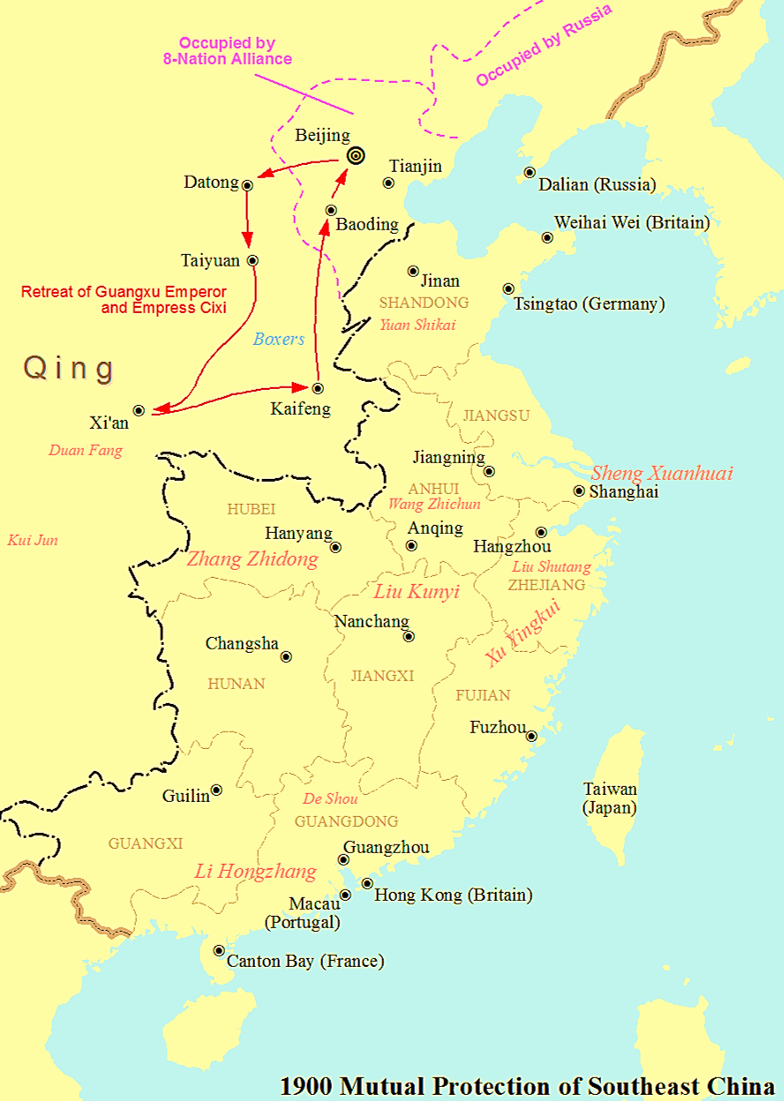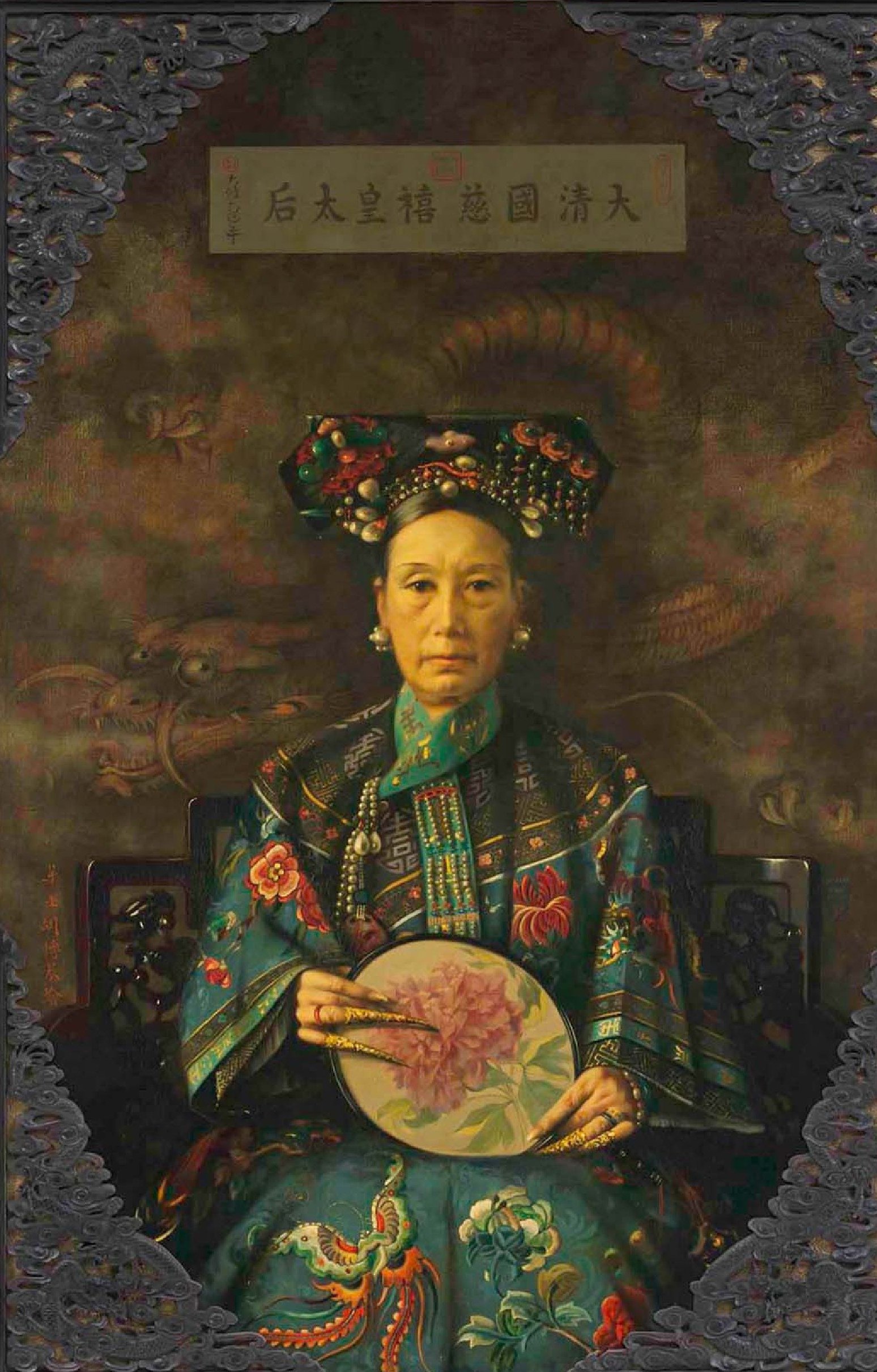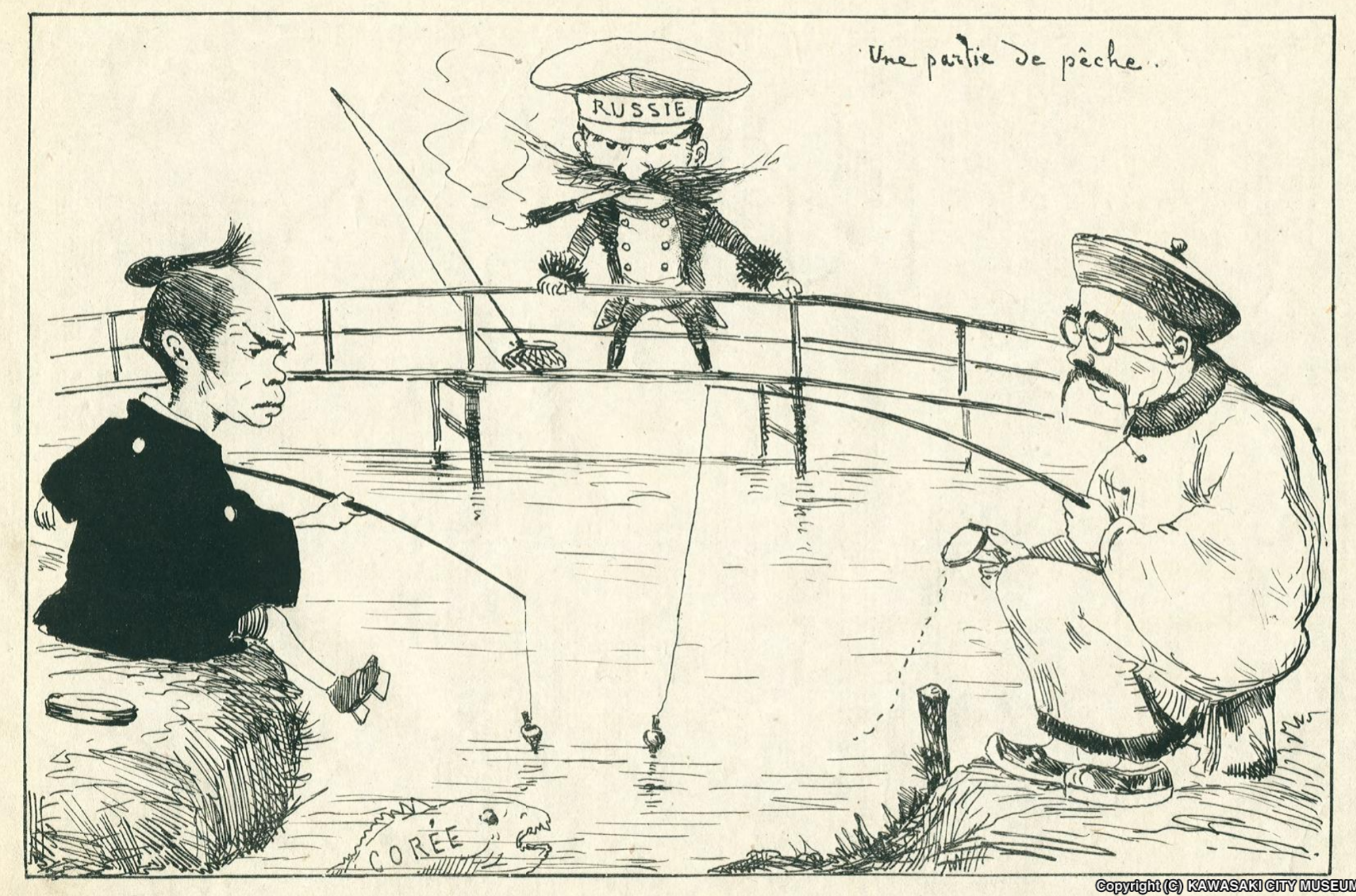|
Mutual Defence Pact Of The Southeastern Provinces
The Mutual Defense Pact of the Southeastern Provinces () was an agreement reached in the summer of 1900 during the Boxer Rebellion by Qing dynasty governors of the provinces in southern, eastern and central China when the Eight-Nation Alliance invaded northern China. The governors, including Li Hongzhang ( governor-general of Guangdong, Guangxi), Xu Yingkui ( governor-general of Fujian, Zhejiang), Liu Kunyi ( governor-general of Jiangsu, Anhui, Jiangxi), Zhang Zhidong ( governor-general of Hubei, Hunan) and Yuan Shikai (provincial governor of Shandong), refused to carry out the imperial decree promulgated by the Qing imperial court to declare war on 11 foreign states, with the aim of preserving peace in their own provinces. Some other Han-majority provincial authorities, such as the governor-general of Sichuan and the provincial governor of Shaanxi, did not formally join the mutual protection agreement but similarly disobeyed the imperial edict. Thus, for the first time, the va ... [...More Info...] [...Related Items...] OR: [Wikipedia] [Google] [Baidu] |
Hushenying
The Hushenying () were a unit of 10,000 Manchu Bannermen under the command of Zaiyi during the Boxer Rebellion. Zaiyi himself created the unit in 1899, but it was decimated at the Battle of Peking in 1900 when the Eight-Nation Alliance captured Beijing to lift the Chinese siege of the foreign legations during the Boxer Uprising. Summary Hushenying has been translated variously as Tiger Spirit Division, Tiger and Divine Corps, and Tiger Spirit Battalion. Zaiyi, also known as Prince Duan, created the Hushenying in June 1899, for which he gained the praise of Empress Dowager Cixi. The new division contained 10,000 troops, all recruited from the banner armies that garrisoned the capital. Some Chinese sources claim that Zaiyi chose the name Hushenying to convey his dislike of foreigners – since "tiger eats lamb (''Yang'', a pun on foreigners), and the divine tames the devil (''Gui'')" – but this claim cannot be verified in the documents of the time. The Hushenying became the t ... [...More Info...] [...Related Items...] OR: [Wikipedia] [Google] [Baidu] |
Manchu People
The Manchus (; ) are a Tungusic peoples, Tungusic East Asian people, East Asian ethnic group native to Manchuria in Northeast Asia. They are an officially recognized Ethnic minorities in China, ethnic minority in China and the people from whom Manchuria derives its name. The Later Jin (1616–1636), Later Jin (1616–1636) and Qing dynasty, Qing (1636–1912) dynasties of China were established and ruled by the Manchus, who are descended from the Jurchen people who earlier established the Jin dynasty (1115–1234), Jin dynasty (1115–1234) in northern China. Manchus form the largest branch of the Tungusic peoples and are distributed throughout China, forming the fourth largest ethnic group in the country. They are found in 31 Chinese provincial regions. Among them, Liaoning has the largest population and Hebei, Heilongjiang, Jilin, Inner Mongolia and Beijing have over 100,000 Manchu residents. About half of the population live in Liaoning and one-fifth in Hebei. There are a ... [...More Info...] [...Related Items...] OR: [Wikipedia] [Google] [Baidu] |
Siege Of The International Legations
The siege of the International Legations was a pivotal event during the Boxer Rebellion in 1900, in which foreign diplomatic compounds in Peking (now Beijing) were besieged by Chinese Boxers and Qing Dynasty troops. The Boxers, fueled by anti-foreign and anti-Christian sentiments, targeted foreigners and Chinese Christians, causing approximately 900 soldiers, sailors, marines, and civilians from various nations, along with about 2,800 Chinese Christians, to seek refuge in the Legation Quarter. The Qing government, initially ambivalent, ultimately supported the Boxers following international military actions. The siege lasted 55 days, marked by intense combat and a brief truce, until an international relief force arrived from the coast, defeated the Qing forces, and lifted the siege. The failure of the siege and the subsequent occupation of Peking by foreign powers significantly weakened the Boxer Rebellion, leading to its eventual suppression, and increased foreign influence and ... [...More Info...] [...Related Items...] OR: [Wikipedia] [Google] [Baidu] |
Imperial Decree Of Declaration Of War Against Foreign Powers
The Imperial Decree of declaration of war against foreign powers () was a simultaneous declaration of war by the Qing dynasty on June 21, 1900 against eleven foreign powers which held varying degrees of influence in China: Russia, the United States, the United Kingdom, Japan, France, Germany, Italy, Spain, Austria-Hungary, Belgium, and the Netherlands. The declaration of war was one of the Eight-Nation Alliance's formation, which then led to Boxer Protocol. This Imperial decree was officially issued in the name of Guangxu Emperor, bearing his official Imperial seal. The Emperor of China was in effect under house arrest, ordered by Empress Dowager Cixi at that time, and the full administrative power was in the hand of the Empress Dowager. The origin of the war Kang Youwei and Liang Qichao Liang Qichao (Chinese: 梁啓超; Wade–Giles: ''Liang2 Chʻi3-chʻao1''; Yale romanization of Cantonese, Yale: ''Lèuhng Kái-chīu''; ) (February 23, 1873 – January 19, 1929) was ... [...More Info...] [...Related Items...] OR: [Wikipedia] [Google] [Baidu] |
Empress Dowager Cixi
Empress Dowager Cixi ( ; 29 November 1835 – 15 November 1908) was a Manchu noblewoman of the Yehe Nara clan who effectively but periodically controlled the Chinese government in the late Qing dynasty as empress dowager and regent for almost 50 years, from 1861 until her death in 1908. Selected as a Concubinage in China, concubine of the Xianfeng Emperor in her adolescence, she gave birth to a son, Zaichun, in 1856. After the Xianfeng Emperor's death in 1861, his five-year-old son became the Tongzhi Emperor, and Cixi assumed the role of co-empress dowager alongside Xianfeng's widow, Empress Dowager Ci'an. Cixi ousted a group of regents appointed by the late emperor and assumed the regency along with Ci'an. Cixi then consolidated control over the dynasty when she installed her nephew as the Guangxu Emperor at the death of the Tongzhi Emperor in 1875. Ci'an continued as co-regent until her death in 1881. Cixi supervised the Tongzhi Restoration, a series of moderate reforms that hel ... [...More Info...] [...Related Items...] OR: [Wikipedia] [Google] [Baidu] |
Guangxu Emperor
The Guangxu Emperor (14 August 1871 – 14 November 1908), also known by his temple name Emperor Dezong of Qing, personal name Zaitian, was the tenth Emperor of China, emperor of the Qing dynasty, and the ninth Qing emperor to rule over China proper, from 1875 to 1908. His succession was endorsed by dowager empresses Empress Dowager Ci'an, Ci'an and Empress Dowager Cixi, Cixi for political reasons after Emperor Tongzhi died without an heir. Cixi held political power for much of Guangxu's reign as regent, except for the period between his assumption of ruling powers in 1889 and the Hundred Days' Reform in 1898. The Qing Empire's prestige and sovereignty continued to erode during Guangxu's reign with defeats in the Sino-French War, the First Sino-Japanese War, and the Boxer Rebellion. Guangxu engaged intellectuals like Kang Youwei and Liang Qichao to develop the Hundred Days' Reform program of 1898 to reverse the decline. Among the goals was removing Cixi from power. The program ... [...More Info...] [...Related Items...] OR: [Wikipedia] [Google] [Baidu] |
First Sino-Japanese War
The First Sino-Japanese War (25 July 189417 April 1895), or the First China–Japan War, was a conflict between the Qing dynasty of China and the Empire of Japan primarily over influence in Joseon, Korea. In Chinese it is commonly known as the Jiawu War. After more than six months of unbroken successes by Japanese land and naval forces and the loss of the ports of Lüshunkou (Port Arthur) and Weihaiwei, the Qing government sued for peace in February 1895 and signed the Unequal treaties, unequal Treaty of Shimonoseki two months later, ending the war. In the late 19th century, Korea remained one of China's tributary states, while Japan viewed it as a target of imperial expansion. In June 1894, the Qing government, at the request of the Korean emperor Gojong of Korea, Gojong, sent 2,800 troops to aid in suppressing the Donghak Peasant Revolution. The Japanese considered this a violation of the 1885 Convention of Tientsin, and sent an expeditionary force of 8,000 troops, which la ... [...More Info...] [...Related Items...] OR: [Wikipedia] [Google] [Baidu] |
Blagoveshchensk Massacre And Sixty-Four Villages East Of The River Massacre
The 1900 Amur anti-Chinese pogroms ( zh, t=庚子俄難) were a series of ethnic killings (pogroms) and reprisals undertaken by the Russian Empire against subjects of the Qing dynasty of various ethnicities, including Manchu, Daur, and Han peoples. They took place in Blagoveshchensk and in the Sixty-Four Villages East of the River in the Amur region, during the same time as the Boxer Rebellion in China. The events ultimately resulted in thousands of deaths, the loss of residency for Chinese subjects living in the Sixty-Four Villages East of the River, and increased Russian control over the region. The Russian justification for the pogroms were attacks made on Russian infrastructure outside Blagoveshchensk by Chinese Boxers, which was then responded by Russian force. The pogroms themselves occurred in . Name The name for the killings and reprisals that occurred in Amur is not standardized, and has been referred to by different names over time. The most common Chinese name f ... [...More Info...] [...Related Items...] OR: [Wikipedia] [Google] [Baidu] |
Daur People
The Daurs, Dagur, Daghur, or Dahur ( Dagur:Daure; Khalkha Mongolian: , ; ; Russian: Дауры, Daury) are a Mongolic people originally native to Dauriya and now predominantly located in Northeast China (and Siberia, Russia, in the past). The Daur form one of the 56 ethnic groups officially recognized in the People's Republic of China. They numbered 131,992 according to the latest census (2010) and most of them live in Morin Dawa Daur Autonomous Banner in Hulun Buir, northeastern Inner Mongolia and Meilisi Daur District in Qiqihar, Heilongjiang, Northeast China. Some Daur people also live near Tacheng in Xinjiang. Language The Dagur language is a Mongolic language. There is a Latin-based orthography which has been devised by a native Daur scholar. The Dagur language retains some Khitan substratal features, including a number of lexemes not found in other Mongolic languages. It is made up of three dialects: Batgan, Hailar, Qiqihar. During Qing rule, some Daur spoke and ... [...More Info...] [...Related Items...] OR: [Wikipedia] [Google] [Baidu] |
Russian Invasion Of Manchuria
The Russian invasion of Manchuria or Chinese expedition () occurred in the aftermath of the First Sino-Japanese War (1894–1895) when concerns regarding Qing China's defeat by the Empire of Japan, and Japan's brief occupation of Liaodong, caused the Russian Empire to speed up their long held designs for imperial expansion across Eurasia. In the five years preceding the invasion, the Russian Empire established a network of leased territories in Manchuria. This began with the Triple Intervention in 1895. From 1898, after which Russia received Liaotung from Japan, it built and operated the Chinese Eastern Railway (CER). As with all other major powers in China, Russia demanded concessions along with the railroad, enforced through unequal treaties. With the building of a southern branch of the CER (later the South Manchuria Railway), Mukden (now known as Shenyang) became a Russian stronghold. During the Boxer Rebellion, the Russian military temporarily evacuated from and im ... [...More Info...] [...Related Items...] OR: [Wikipedia] [Google] [Baidu] |
Honghuzi
Honghuzi () were armed Chinese robbers and bandits who operated in the areas of the eastern Russia-China borderland during the second half of the 19th century and the first half of the 20th century. Their activities extended over southeastern Siberia, the Russian Far East, and Manchuria/Northeast China. The word ''honghuzi'' has been variously transliterated as hong huzi, hunhutsi, hong hu zi, hunghutze, hun-hutze, etc. There is also a common transliteration from Russian, khunkhuzy (), and a back-formation for the singular, khunkhuz (). Korean immigrants to Manchuria in the 20th century called the honghuzi ma-jeok (마적,馬賊). Groups of honghuzi were recruited as guerrillas by the Imperial Japanese Army during the Russo-Japanese War of 1904-1905 into sabotage units. Resistance to foreign occupation Near the end the 19th century the honghuzi harassed Russian efforts to build the Manchurian Railway and in general plagued the Russian troops in Manchuria. The Honghuzi partic ... [...More Info...] [...Related Items...] OR: [Wikipedia] [Google] [Baidu] |






